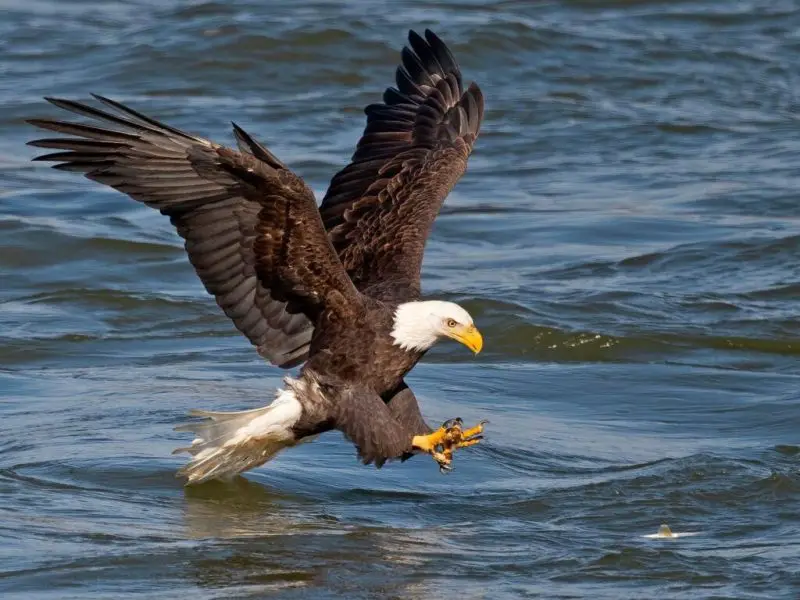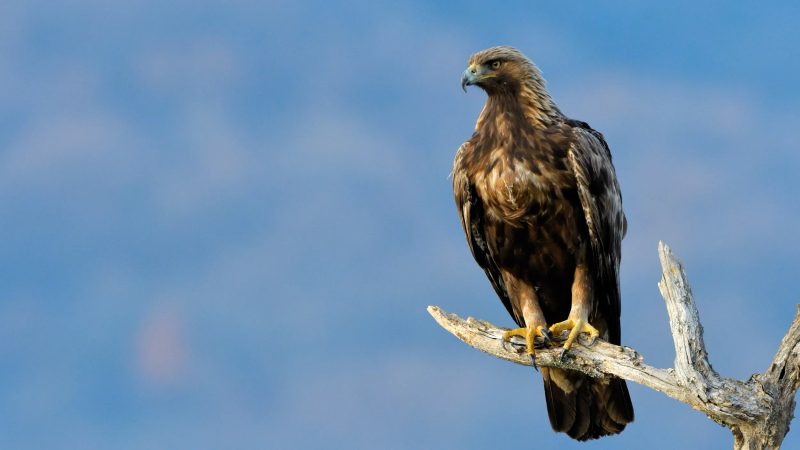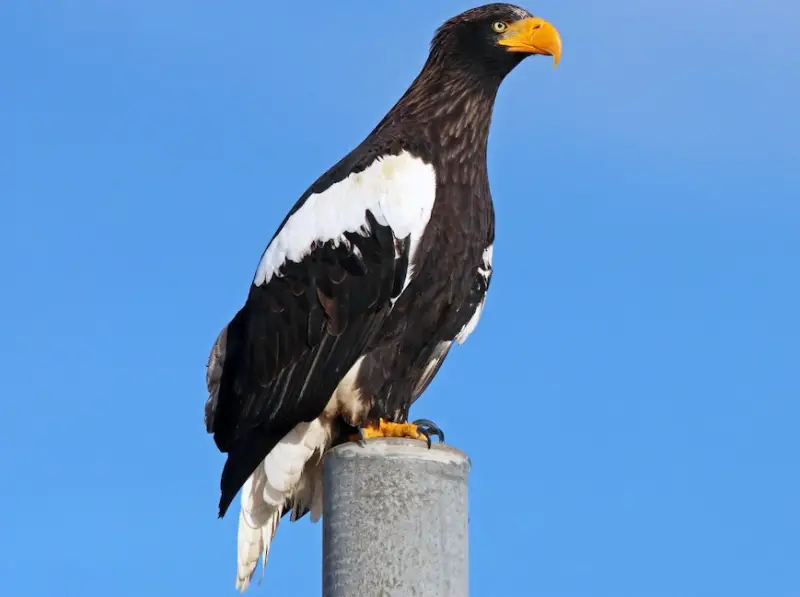Pennsylvania boasts a rich diversity of wildlife, and among its most awe-inspiring residents are the eagles. These powerful birds of prey are not only symbols of strength and freedom but also vital members of the state’s ecosystems. Their presence reflects healthy habitats, from rivers and lakes to rugged mountain ridges.
Three eagle species can be found in Pennsylvania: the iconic Bald Eagle, known for its striking white head and tail; the elusive Golden Eagle, a master of open ridges and mountainous terrain; and the rare visitor, the Steller’s Sea Eagle, which occasionally wanders far from its native northeastern Asia. Each species brings unique behaviors and adaptations to the landscapes they inhabit.
In this guide, we will take a detailed look at these majestic birds. From their physical characteristics and hunting techniques to habitat preferences and migration patterns, this comprehensive overview will help birdwatchers and nature enthusiasts identify and appreciate the eagles of Pennsylvania.
Bald Eagle (Haliaeetus leucocephalus)

Physical Characteristics & Identification
The Bald Eagle is perhaps the most recognizable bird of prey in North America. Adults are distinguished by their striking white heads and tails, contrasting with dark brown bodies and wings. They possess a powerful yellow beak and large, hooked talons. Juveniles, however, have dark brown plumage with mottled white patterns and don’t attain the adult coloration until they are about five years old.
Size & Wingspan
Bald Eagles are among the largest raptors in North America. They have a wingspan ranging from 6 to 7.5 feet (1.8 to 2.3 meters) and can weigh between 3 to 6.3 kilograms (6.6 to 13.9 pounds). Females are typically larger than males.
Behavior
Bald Eagles are known for their keen eyesight and powerful flight. They are primarily solitary outside the breeding season but can be seen in groups when food is abundant, such as during salmon runs. Their flight is characterized by slow, deliberate wingbeats and soaring on thermal updrafts.
Feeding & Hunting Habits
Bald Eagles are opportunistic feeders, primarily consuming fish but also hunting waterfowl and scavenging carrion. They often hunt by swooping down to grab prey from the water’s surface with their talons. In winter, they may congregate near ice-free waters where fish are concentrated.
Habitat & Distribution
In Pennsylvania, Bald Eagles are found near large bodies of open water, including rivers, lakes, and marshes, which provide abundant food sources. They prefer forested areas for nesting, often selecting tall, mature trees or man-made structures like platforms. While once endangered in the state, conservation efforts have led to a significant recovery, with over 260 active nests reported in recent years.
Migration
Bald Eagles in Pennsylvania are primarily resident birds, but some may migrate short distances in winter to find open water. Most remain in the state year-round, especially where food sources are reliable.
Interesting Facts
-
Bald Eagles mate for life and return to the same nest year after year.
-
Their nests are among the largest of any bird species, sometimes weighing over 1,000 pounds.
-
The Bald Eagle was chosen as the national bird of the United States in 1782.
Golden Eagle (Aquila chrysaetos)

Physical Characteristics & Identification
Golden Eagles are large, dark brown raptors with a golden-brown sheen on the back of their heads and necks. They have a robust build, with a slightly rounded tail and long, broad wings. Unlike Bald Eagles, they lack the white head and tail, making them more challenging to identify at a distance.
Size & Wingspan
Golden Eagles are slightly larger than Bald Eagles, with wingspans ranging from 6 to 7.5 feet (1.8 to 2.3 meters) and weights between 3 to 7 kilograms (6.6 to 15.4 pounds). Females are generally larger than males.
Behavior
Golden Eagles are known for their agility and speed, often hunting in open terrains. They are solitary outside the breeding season and are highly territorial. Their flight is characterized by rapid wingbeats and soaring on thermal currents.
Feeding & Hunting Habits
Golden Eagles are formidable hunters, preying on a variety of mammals, including rabbits, squirrels, and even deer fawns. They hunt by flying low over the ground and ambushing prey with swift strikes. In Pennsylvania, they are often seen hunting along the ridgelines of the Appalachian Mountains during migration.
Habitat & Distribution
In Pennsylvania, Golden Eagles are primarily found in the Ridge and Valley Province, particularly between the Allegheny Front and the Kittatinny Ridge. They prefer open, rugged terrains such as cliffs and ridgelines, which provide suitable nesting sites and hunting grounds.
Migration
Golden Eagles are migratory birds, traveling along the Appalachian ridgelines during their annual migration. In spring, they head north to their breeding grounds, and in autumn, they return south. Pennsylvania serves as a critical stopover point during these migrations.
Interesting Facts
-
Golden Eagles can dive at speeds exceeding 150 miles per hour (240 km/h) when hunting.
-
They build large nests on cliffs or in tall trees, which they may use for several years.
-
Golden Eagles have been known to cooperate with humans in traditional falconry practices.
Steller’s Sea Eagle (Haliaeetus pelagicus)

Physical Characteristics & Identification
The Steller’s Sea Eagle is one of the largest eagles, with a massive, powerful build. Adults have dark brown bodies, white shoulders, and a striking yellow-orange beak. Their large size and distinctive coloration make them easily identifiable, though they are rarely seen in Pennsylvania.
Size & Wingspan
Steller’s Sea Eagles are among the heaviest eagles, with wingspans ranging from 6.5 to 8 feet (2 to 2.4 meters) and weights between 6.3 to 9 kilograms (14 to 20 pounds). They are slightly larger than Bald Eagles and significantly heavier.
Behavior
Steller’s Sea Eagles are primarily solitary and are known for their powerful flight and hunting skills. They are less prone to vagrancy compared to other eagle species but have been observed far from their native ranges on occasion.
Feeding & Hunting Habits
These eagles primarily feed on fish, favoring species like salmon and trout. They are also known to hunt water birds, land birds, mammals, and occasionally scavenge carrion. Their hunting technique involves swooping down to capture prey with their powerful talons.
Habitat & Distribution
Native to the coastal regions of northeastern Asia, including the Kamchatka Peninsula and the Sea of Okhotsk, Steller’s Sea Eagles prefer habitats with large, mature trees near bodies of water. While sightings in Pennsylvania are extremely rare, there have been isolated reports of individuals straying far from their usual range.
Migration
Steller’s Sea Eagles are migratory, moving south from their breeding grounds in northeastern Asia to winter in regions like Hokkaido, Japan. Their migration patterns are influenced by ice conditions and food availability.
Interesting Facts
-
The Steller’s Sea Eagle has one of the most powerful beaks among birds of prey.
-
It is considered a vulnerable species, with an estimated population of only 3,000 to 5,000 individuals worldwide.
-
The first confirmed sighting in the contiguous United States occurred in Texas in 2020.
Where to Spot Eagles in Pennsylvania
Bald Eagles
Bald Eagles can be observed throughout Pennsylvania, particularly near large bodies of water such as the Susquehanna River, the Delaware River, and Lake Erie. These areas provide abundant fish, the primary food source for Bald Eagles, making them ideal for eagle-watching.
Notable viewing locations include the Conowingo Dam, where eagles gather in large numbers during the winter to feed on migrating fish, and the Delaware Water Gap, which offers excellent riverfront vantage points for observing both perching and soaring eagles. Other prime locations include Presque Isle State Park, Pymatuning Reservoir, and Ricketts Glen State Park, where the combination of forests and open water creates perfect nesting and hunting habitats.
The best time to observe Bald Eagles in Pennsylvania is from late fall through early spring, when ice-free waters concentrate fish and increase eagle activity. Early mornings and late afternoons are particularly favorable for spotting eagles in flight, and using binoculars or spotting scopes can greatly enhance the viewing experience. It is important to maintain a safe distance from nests and feeding areas to avoid disturbing these protected birds.
Golden Eagles
Golden Eagles are more elusive and less commonly seen in Pennsylvania. They are primarily observed along ridge lines of the Appalachian Mountains, including the Kittatinny Ridge and the Allegheny Front. These elevated terrains provide optimal hunting grounds and vantage points for migration.
The fall migration, from September to November, is the best time to spot these majestic raptors soaring over open ridges. Golden Eagles often ride thermal updrafts, gliding gracefully above valleys and ridgelines. Because they fly high and cover large distances, binoculars or spotting scopes are highly recommended for observation. Early mornings and late afternoons, when thermal currents are most active, increase the likelihood of sightings.
Golden Eagles are solitary hunters and highly territorial. Birdwatchers should respect their space and avoid approaching nests or hunting areas. Observing along designated trails or ridge overlooks ensures both safety and an unobstructed view of these powerful eagles in action.
Steller’s Sea Eagles
Sightings of Steller’s Sea Eagles in Pennsylvania are extremely rare, as these birds are primarily native to northeastern Asia. Most individuals reported in the state are vagrants, usually appearing during winter months when they wander far from their native range in search of food.
Birdwatchers at large reservoirs, lakes, or rivers may occasionally glimpse one of these giants, though such sightings are unpredictable and require patience. Observers should carefully scan distant treelines, water edges, and open skies for signs of this massive raptor. Steller’s Sea Eagles are known for their powerful build and striking yellow-orange beak, which makes them unmistakable when spotted.
Due to their rarity, any sighting is considered remarkable. Birdwatchers should avoid attempting to approach the bird and instead enjoy the observation from a safe distance, using binoculars or spotting scopes to capture a close view without causing disturbance.
FAQs About Eagles in Pennsylvania
How many eagle species live in Pennsylvania?
Pennsylvania is home to three eagle species: the Bald Eagle, Golden Eagle, and the rare vagrant Steller’s Sea Eagle. The Bald Eagle is the most commonly seen, while Golden Eagles are rarer and primarily observed during migration. Steller’s Sea Eagles are extremely rare visitors.
Where can I see Bald Eagles in Pennsylvania?
Popular spots include the Susquehanna River, Delaware River, Lake Erie, Conowingo Dam, Delaware Water Gap, Presque Isle State Park, and Pymatuning Reservoir. The best viewing time is late fall through early spring, when eagles gather near ice-free waters to hunt fish.
Are Golden Eagles common in Pennsylvania?
Golden Eagles are rare but regular visitors, especially during the fall migration along Appalachian ridges. The Kittatinny Ridge and Allegheny Front are prime observation locations. These eagles prefer open ridges and mountainous terrain, making them more elusive than Bald Eagles.
What is the difference between Bald Eagles and Golden Eagles?
Bald Eagles have white heads and tails and are usually found near large bodies of water. Golden Eagles have golden-brown plumage on the head and neck and favor mountain ridges and open terrains. Behaviorally, Bald Eagles are more social near food sources, while Golden Eagles are solitary hunters.
Can Steller’s Sea Eagles be found in Pennsylvania?
Steller’s Sea Eagles are rare vagrants in Pennsylvania. They originate from northeastern Asia and are occasionally spotted in winter near lakes or rivers, but sightings are highly unusual. Any observation of this species is considered exceptional.
Is it legal to feed eagles in Pennsylvania?
No. Eagles are protected under federal law (Bald and Golden Eagle Protection Act). Feeding, harassing, or disturbing eagles can result in severe fines and legal penalties. Observation should always be done from a safe distance.
When is the best time to watch eagles in Pennsylvania?
-
Bald Eagles: Late fall through early spring.
-
Golden Eagles: September to November during migration.
-
Steller’s Sea Eagles: Winter months, although sightings are rare.
What equipment do I need for eagle watching?
Using binoculars or spotting scopes is highly recommended. Early morning or late afternoon provides the best lighting and thermal conditions for flight. Long-distance observation ensures safety and minimizes disturbance to the birds.
Why are eagles important to Pennsylvania’s ecosystem?
Eagles are top predators, helping control fish and small mammal populations. They also serve as indicators of environmental health, with thriving eagle populations signaling healthy waterways, forests, and open habitats.
Can I photograph eagles in the wild?
Yes, but it’s important to keep a respectful distance, avoid disturbing nests, and use telephoto lenses for close-up shots. Observing eagles responsibly ensures their protection and continued presence in Pennsylvania.






